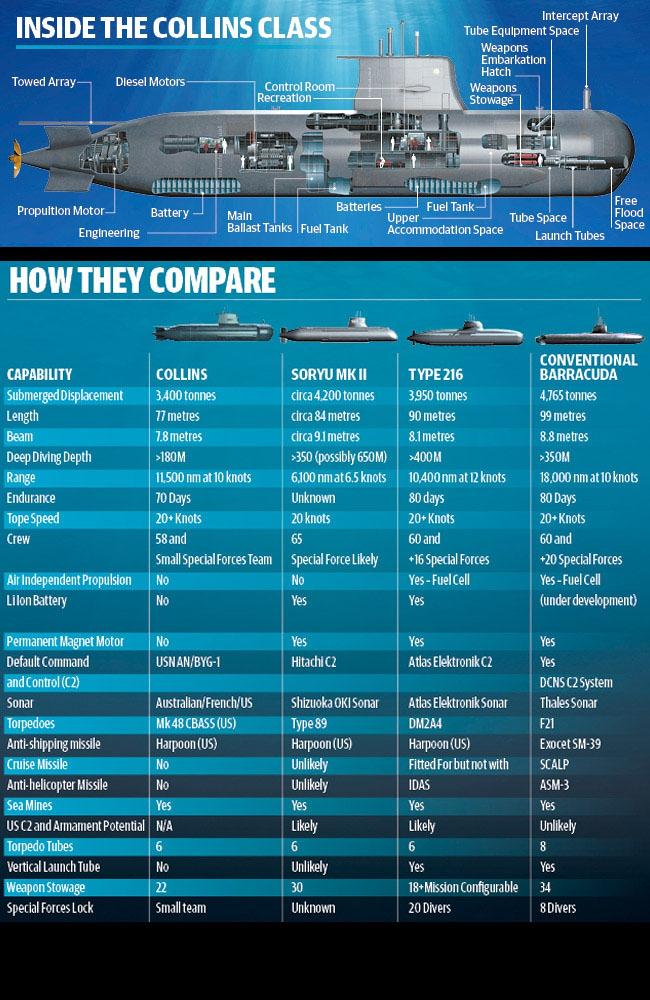Comparison of the Collins with the three (Japan, Germany and France) Australian Future Submarine contenders - using open source information as at early May 2015. (Comparison Table courtesy of News Corp Australia article of May 16, 2015)
Note there are several mistakes or misleading figures in the Table above. This is partly owing to the Table's mix of current capabilities and estimated future capabilities which may be in 10 years time (2025). Clear current mistakes are:
- conventional Barracuda's surfaced Displacement is likely to be 4,765 tonnes. Submerged displacement would not be the 4,765 tonnes listed but more likely 5,300 tonnes if the Barracuda SSN's published figures are accurate.
- Conventional Barracuda's estimated range (18,000 nm) is not current - it is what this sub may have in 2025 if Australia chooses it.
- The Soryu's current Weapon Stowage is believed to be equivalent of 20 heavyweight torpedos/Harpoon missiles OR 10 torpedos/Harpoon missiles + 20 (smaller) mines = 30 weapons.
- The Soryu's current range is believed to be 6,100 nm but the "Super SoryuAU" (name first christened here) estimated range in 2025 may be more like 11,000 nm.
- If the Japanese option is selected Japan may well develop a fuel cell AIP (probably with German help).
- If the Japanese option is selected Japan may well develop a fuel cell AIP (probably with German help).
- The TKMS website for the Type 216 gives the normal crew as 33 - a very important figure in view of Australia's chronic submarine crew shortages. I do not know who or how "60" was estimated.
---
Australian companies and business groups, the South Australian Government and to a lesser extent other State Governments continue to press for "Build future submarine in Australia".
While the Federal Labor Opposition (Bill Shorten) Party also advocates "Build in Australia" it has already said it will honour any contract made by the Abbott Coalition Government (which may be Build in Japan, Germany or France).
The Australian Made Defence organisation in 2015 listed "7 PROBLEMS WITH THE JAPANESE OPTION" some of which apply to Build in Japan only but other problems may also apply to Build in Germany or France. The Australian Made Defence list of 7 problems is http://australianmadedefence.com.au/our-capabilities/7-problems-with-the-japanese-option/:
While the Federal Labor Opposition (Bill Shorten) Party also advocates "Build in Australia" it has already said it will honour any contract made by the Abbott Coalition Government (which may be Build in Japan, Germany or France).
The Australian Made Defence organisation in 2015 listed "7 PROBLEMS WITH THE JAPANESE OPTION" some of which apply to Build in Japan only but other problems may also apply to Build in Germany or France. The Australian Made Defence list of 7 problems is http://australianmadedefence.com.au/our-capabilities/7-problems-with-the-japanese-option/:
Quote
"There are a number of issues with plans to build Australia’s next fleet of submarines in Japan.
- What are the risks? It is industry’s understanding that Japanese submarines are designed for short range, cold water operations. Australia’s submarines are required to travel long distances and operate primarily in warm tropical water. Industry is concerned that this and additional Australian system integration requirements will necessitate significant design changes that induces substantial additional risk if the submarines are redesigned and built in Japan.
- Will Australia have to pay for the development of a new shipyard and workforce in Japan to build it submarines? Industry has been advised Japan produces one submarine each year as an industrial and employment policy. The submarines are built in two shipyards; and those two shipyards are programmed to build submarines for the Japanese Maritime Self Defence Force for decades into the future. Industry is concerned that to build Australia’s submarines in Japan it will require the development of a new shipyard and workforce in Japan thereby compromising existing capabilities in Australia.
- How long do Japanese submarines last? Because of Japan’s long-term shipbuilding strategy, industry has been advised the Japanese only build submarines to last approximately 15 years, as opposed to the traditional 25-30 year life of Australia Navy vessels. This means the Japanese do not factor major upgrades or overhauls into their design philosophy, which greatly limits the through life deeper level sustainment work available to be done by Australian industry.
- What will be Australia’s capacity to sustain submarines built in Japan? The more Australian industry involvement there is in the design and build of the submarines the greater understanding it will have of the design philosophy and associated intellectual property. The greater understanding industry has of the design and build of the submarines the more capable it is to do the deeper level maintenance and repairs. If Japan designs and builds the submarines in Japan, there will be very limited capacity for Australian industry to perform any deeper level sustainment in Australia.
- Can the hulls be built in Japan and fitted-out in Australia?It has been suggested that an option might be to build the submarine hulls in Japan and transport them to Australia for final systems integration and fit-out. Industry’s advice is that this is particularly difficult with submarines as they will need to be constructed in fully integrated sections which are then sealed as a homogeneous pressure hull. There is very little capacity to fit-out a submarine once the hull is complete.
- How do we go in times of trouble?Industry is concerned that if it is not intimately involved in the design and build of submarines constructed in Japan, how dependent will Australia be on an extended supply chain back to Japan for support and supplies? These security concerns are heightened in times of trouble when those supply lines might be threatened.
- Will we repeat the problems of the past?The Japanese have not exported arms or been involved in collaborative defence procurements in decades. Industry is concerned that Australia doesn’t repeat the problems of the past in relation to securing access to intellectual property for technologies and dealing with countries that have not exported their designs."Unquote
Pete
